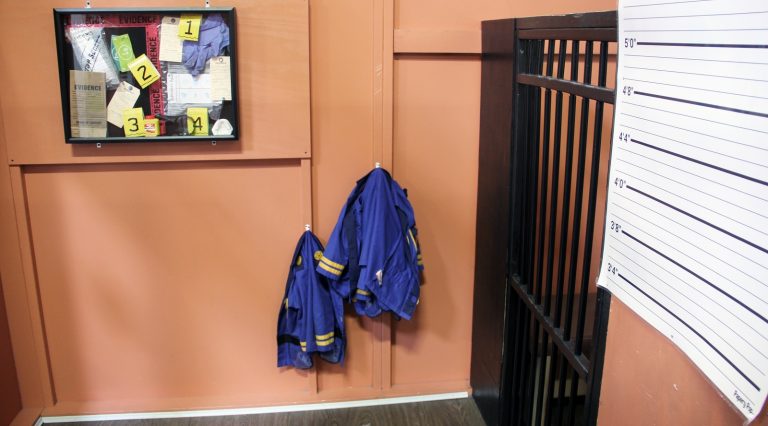—John HAGELIN, in Rhonda BYRNE’s The Secret, 2006
—Jackie WANG, “This is a Story About Nerds and Cops,” in Carceral Capitalism, 2018
From the quotes above, we have a peculiar mashup: it’s a scene where the new-age book The Secret meets the horrors of policing and algorithms.3This pairing contains, along with an uncanny summoning of a sort of Nostrodamous-like magic, two points on a spectrum which we could term ‘a spectrum of determinism,’ two markers on a map of efficient causality. In other words, these quotes refer to two distinct relationships to making reality real.
The Secret is that one’s thoughts constitute material reality. Here, in an Oprah-endorsed Cartesian fantasy of the self, the apparatus of creation—the driver of change—is the mind. This is a sort of twisted protestant immaterial work-ethic such that if I focus enough, I make the universe.4If I dream of getting a new kitchen floor everyday for a year, I will without a doubt, get a new kitchen floor.
But aside from a purely goal-oriented manifestation, The Secret also insists on the impossibility of functional critique: if I think ‘negative’ thoughts, negative things will happen (i.e. criticism or radical opposition will actually just manifest that which is opposed). Following this axiom, if a tree falls with no-one around, it’s probable that someone was protesting the clear-cutting of the forest, which caused the tree to fall in the first place. More seriously, here the secret has a fascistic5side insofar as it posits historical trauma as caused by the exploited-or-worse; though indirectly, it implies any victim of any wrongdoing whatsoever is to be blamed for not dreaming up a different reality hard enough.
That is one side of the equation. From the second quote, at the other end of the constellation, is the current paradigm of data. Here we find the worldview of algorithms, of contemporary computing and communication networks, of artificial intelligence. In this camp, we have the vast majority of usages and assumptions about mathematics, and a specific relationship to truth. This is the apparent neutrality of data, the place where ‘the numbers don’t lie’, of cold-hard facts—an empiricism that is emblematic of, but not exclusive to, our present moment. Broadly, I am situating this empiricism within a long-standing social-scientific outlook built through centuries of categorizing ‘nature’ and ‘the other’ into ordered taxonomies of difference.6
 Byron PETERS, Pure Difference, Video Still, 2017. Photo by Byron PETERS
Byron PETERS, Pure Difference, Video Still, 2017. Photo by Byron PETERS
Predictive policing is the emerging field wherein ‘predictive analytics,’ the domain of data science widely used in the commercial sector (think online-shopping suggestions, the algorithms behind targeted advertising, or the science of estimating earthquake aftershocks), now takes aim at crime. As Jackie WANG shows us, the current uptake of these technologies in the U.S.A. parallels a moment where police departments are facing a crisis of legitimacy (considering the apt and widespread of critique of police forces as propagating deadly racialized violence), while at the same time these softwares provide false-positives that bolster business success (in this case, for PredPol7)). And, although these systems are marketed with claims of neutrality, WANG points out that “using crime data gathered by the police to determine where officers should go simply sends police to patrol the poor neighbourhoods where they have historically patrolled when they were guided by their intuitions and biases.”8
The input of racially biased information into supposedly objective, data-driven systems not only creates self-fulfilling prophesies, but as researcher Kate CRAWFORD has described more generally, the venture into analytics risks vastly strengthening bias itself, especially when the system appears as novel, irreducibly complex, or artificially intelligent.9Indeed, the histories of science and racialization are riddled with examples where death, violence, and exclusion have been justified by the infallible rubrics of facts. In our current moment, imagine a scenario akin to the Spielberg film Minority Report, where the ‘PreCrime’ police state is composed of ‘PreCogs’ who, rather than being clairvoyant, are merely dedicated practitioners of Rhonda BYRNE’s The Secret.
I bring up these examples not simply to pull focus on new-age cultures nor specific uses of algorithms, but to take a look at some of the underpinnings of contemporary causality more generally. It is the what-determines-what that interests me here.
Though it appears as a sort of liberal self-help mantra, mystical-dressing aside, the causality within The Secret is a particular cocktail of historical denial and libertarianism10reminiscent of the current far-right positions in mainstream politics. On the other hand, with data-analytics, the obverse is claimed to be true; in this technological-determinism, the tool—not the individual—bolsters, or even determines, truth. In zooming out to view the whole constellation, we find a sort of “progress without people”11paired with the continued ordering of peoples based on whether they are deemed to be a determining-self. The latter is the continued inheritance of a-priori logics that justify the need for policing in the first place.
These separate but oddly compatible determinisms take many forms as they underscore our current moment of heightened individualism, the re-emergence of fascistic power, and advanced computing. They are reminiscent of Christine DELPHY’s “un universalisme si particulier” (particular-universals), whereby a certain set of assumptions made from a particular context come to dominate all contexts.12When living in a particular-universal, other ways of being can be allowed, or even encouraged, but only when subsumed. This is the curtailing of social imagination—at least until the particular-universal sheds its universality under social pressure, to become merely particular.
To go a little farther into the concerns of causation, the social, and technology, I want to talk a bit about mathematics. Specifically, there is a term that has been floating around for some time, at least since the 1960s—‘anti-racist mathematics’.13 I first encountered this phrase when teaching mathematics in London—a friend and fellow teacher, Leslie SCAFE, had been thinking through questions of post-apartheid knowledge production in South Africa. In the 1990s, he had been living and working with this rubric, where the question was simple in form and complex in practice: to move forward without white-supremacy, which knowledges would be carried forward, and which would have to come from a new sociality? As a mathematics educator, Leslie and his colleagues were asking these questions around number, quantification, and the nature of pedagogy.
Both in historical and current practices and theories, there are several ways to look at what ‘Anti-Racist Mathematics’ might be. Perhaps the most direct approach is that of education. Drawing from practices of Paulo FRÈRE’s Pedagogy of the Oppressed alongside ethnomathematics, this could mean a curriculum revision where the technical aspects of the mathematics remain largely the same, but the applications shift to incorporate statistics and word-problems that navigate, for example, racial inequalities, incarceration rates, or class structures. In this hypothetical mathematics classroom, technical knowledges are also learned alongside a contextual understanding of spirituality, colonial histories and global power. For instance, why was zero not used/invented/discovered in Europe until the 13th Century, yet it used in India at least since the Gupta Period? How does al-gabr (Arabic: ‘balance’, or ‘the setting of a broken bone’), originating from the Golden Age of Baghdad relate to its current manifestations as algebra? Or, how does the contemporary notion of the algorithm differ or match with the practice of it’s namesake origin, Muḥammad ibn Mūsā al-Khwārizmī? In this approach, an ontology of mathematics is situated within particular historical and cultural contexts. With regards to causality or determinism, this could either bolster the notion of mathematics as a neutral universal preceding different historical and geographic sites (a sort of ‘world-music’ of mathematics), or, it could demonstrate the particularity of certain logical operations as contingent to human sociality.14 It is the latter that I wish to touch upon here: a speculative potential of mathematics.

This version of the term questions the make-up of the language of mathematics itself; it’s a look at the particular operations and logics that constitute what can (or can’t) be done with a set of tools. Here, much like spoken languages, the phrases and operations of mathematics can be mis-used, even ‘swerved’, to incorporate social priorities that lie outside the dominant usages of applied sciences and the games, models, and atomizing logics of capitalist economics. In thinking with this idea, I draw from Nadim BAKHSHOV’s call for an “alternative mathematics”15 , alongside the anthropological work of Diane M. NELSON in Who Counts: The Mathematics of Death and Life after Genocide, and borrow liberally from Mariana Kawall Leal FERREIRA’s work “When 1+1=2: Making Mathematics in Central Brazil.” Dancing in and around these texts is a common thought-experiment: let’s say I have 10 _______ and I give 3 of them away. How many do I have left?
Perhaps the most readily available response would be to treat this question as “10-3=?”. If I no longer have possession of 3, then I must have 7 remaining, i.e. 10-3=7. On the other hand, if I am living in a form of mutuality wherein the privatization of goods, ideas, care, and struggles is not the default steady-state of existence, I might not consider the offering of 3 _______ to be a loss. The calculation then is a description of offering access to 3 _______ to someone who was previously not involved. In this case, we could have a generative subtraction, or in other words, 10-3=13.
Once we decide to open up basic mathematical/logical operations as such, clearly there are innumerable ways that we could re-write or interpret this hypothetical scenario. We could, for example, interpret these two descriptive possibilities as an inversion from a model of financial debt (subtractive-subtraction fit to an economics based on scarcity and credit, where property defines the bonds between people) into something else that might be something like Fred MOTEN and Stefano HARNEY’s “mutual debt that can never be made good,” a debt without a creditor.16If we were to build from this point, a mathematics might not need accurate relationships to quantity, but rather a sort of topological beingness that incorporates and exceeds the qualitative of the social.
This is not to say that 10-3 doesn’t equal 7 sometimes—to do away with ‘standard’ subtraction would also be a dismissal of certain forms of a-countability, and might risk entering into a sort of totalizing reckless indeterminacy, or a even mathematical “tyranny of structureless”17—but rather that 10-3 also equals 13. In a parallel historical example, Wenhoron SUYÁ, an attendee of the Diauarum School in Central Brazil, when asked a similar question by Leal FERREIRA, responds “I know you want me to use the minus sign here instead of the plus sign, but I don’t understand, why does giving away always mean minus for you guys?”18
To be clear, this speculative example is meant to illustrate a moment of mathematical presence: an instance where an inversion momentarily makes more sense than a previously assumed logic. Here, a different pragmatism, one that might exceed pragmatism as we know it, forms the basis for mathematical thought. Rather than being a mistake that SUYÁ is encouraged not to make, we choose “-” to perform an additive subtraction. I describe this as an instance, because our second thought might be to simply replace the “-” with a “+”, and then to situate this standard logic in a more mutual sociality. But, by doing so, we would also be closing the opportunity for a separate logic to exist to form the basis for other axioms, to become a mathematics bound to a different set of assumptions about being, from whence it came.
In the world of 10-3=13, the map is not the territory—no invention nor language precedes the social. From this starting point, we can ask more from the particular universals we have inherited, to begin to open them up together, until their false efficiency spills out and creates a mess that we won’t want to clean up.